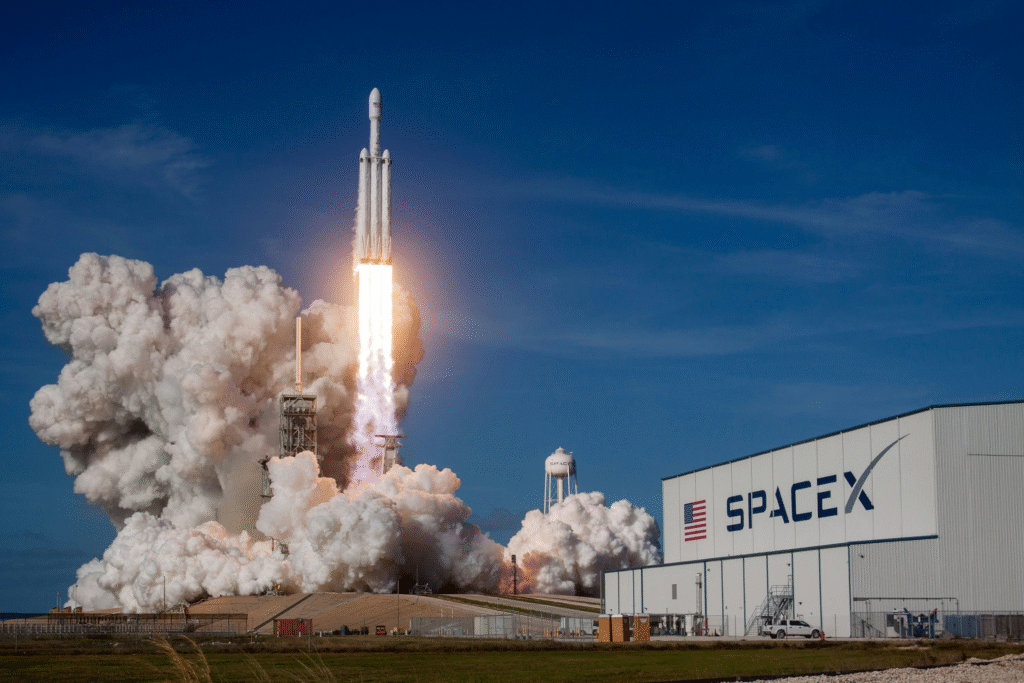Sometimes even the biggest dreams have to wait for a little while. That is exactly what happened with SpaceX, the space company owned by Elon Musk. On Sunday evening, the company had planned to launch its huge Starship rocket for the tenth time. But just before takeoff, a problem showed up in the ground system, and the team decided to pause the mission instead of risking a failure.
The Starship rocket is not an ordinary spacecraft. It is the tallest and most powerful rocket ever built, designed to take people and supplies not only around Earth but also to the Moon and Mars one day. The rocket is made of two main parts: the Super Heavy booster, which is about 232 feet tall, and the Starship spacecraft on top, which is around 171 feet tall. Together, they look like a giant tower waiting to reach the skies. This test flight was supposed to be an important step forward, but instead, it became another reminder that building such a big rocket is never easy.
On Sunday, the rocket was already standing tall on its launch pad at Starbase, the company’s launch site in Texas. Engineers had started filling it with propellants, preparing it for liftoff at around 7:35 p.m. Eastern Time. Excitement was building up, and many fans across the world were waiting to see if this test would finally go smoothly. But about 30 minutes before launch, SpaceX posted a message on X (formerly Twitter) saying they had to stand down. The reason? A problem with the ground systems that support the rocket during takeoff.
This might sound disappointing, but in spaceflight, safety always comes first. A tiny issue on the ground can cause huge problems once the rocket is in the air. By stopping the launch, the engineers showed that they are careful and willing to wait until everything works perfectly. Similar situations have happened in the past, and usually, they were fixed within a few days. That means the rocket could still fly very soon, perhaps as early as Monday, August 25, if everything checks out.

Elon Musk had planned to share an update about the progress of Starship before this launch. Many people were waiting to hear his words and learn more about the future plans for this massive rocket. But because the launch was delayed, the live stream that was meant for updates was also canceled. This shows how closely tied the rocket’s success is to Musk’s vision. For him, Starship is not just another project—it is the key to reaching Mars and making humanity a multi-planetary species.
The road to this dream has not been smooth at all. In fact, the company has faced a number of failures this year while testing Starship. Some rockets exploded shortly after liftoff, while others failed to complete their planned missions. Each setback has been a lesson for the engineers, who study the mistakes carefully to improve the next test. Even though failures can look discouraging, they are actually part of the process in rocket science. Every successful mission in history was built on the lessons learned from earlier attempts.
What made this tenth test so important is that it was expected to try several big things at once. One of the main goals was for the Super Heavy booster to perform a controlled landing in the water off the coast of Texas. This kind of landing is very tricky, but if successful, it would prove that the rocket can be reused for future flights. Reusability is one of the key ideas that makes SpaceX different from older space companies. Instead of throwing away rockets after each flight, Musk wants to recycle them, making space travel cheaper and more practical.
The stakes for SpaceX are very high right now. Starship is not just another rocket in the company’s collection—it is the heart of its future. NASA is depending on Starship to carry astronauts to the Moon in the coming years as part of the Artemis program. Musk himself sees Starship as the vehicle that could someday carry humans to Mars, starting a new chapter for our species. Every test, whether it ends in success or failure, takes the company one step closer to this future.
Some people might wonder why SpaceX does not wait longer before announcing a launch, especially when problems keep showing up. The truth is that rocket development is a very complicated process with thousands of moving parts. Engineers test again and again because only real launches can reveal how the rocket behaves in extreme conditions. Postponements, therefore, are not a sign of weakness but of responsibility. By delaying the flight, the team shows they value progress built on safety rather than rushing to impress the world.
Looking at the bigger picture, it is clear that Starship is still in its early stages. Just like learning to ride a bike involves falls and scrapes, learning to launch a rocket this huge involves setbacks too. Yet, SpaceX has a history of bouncing back stronger after failures. Years ago, the company faced many rocket explosions before finally mastering safe landings of its Falcon 9 boosters. Today, those Falcon 9 rockets launch satellites almost every week with great success. That history gives many people confidence that Starship will eventually overcome its struggles as well.
For now, the rocket continues to stand tall at Starbase, waiting for its chance to fly. Engineers are busy checking the ground systems, trying to fix the issue that stopped the launch. Fans of space exploration are watching closely, hoping that the next attempt will light up the Texas sky with the power of the world’s largest rocket.
The delay may have pushed the dream a little further down the road, but it has not ended it. In fact, each pause only builds more anticipation for the day when Starship finally takes off, completes its mission, and proves it is ready for the grand adventures ahead. Space travel has always been about patience, courage, and the determination to keep going even after setbacks. SpaceX’s Starship is walking that same path today, and the world is waiting to see where it will lead tomorrow.


